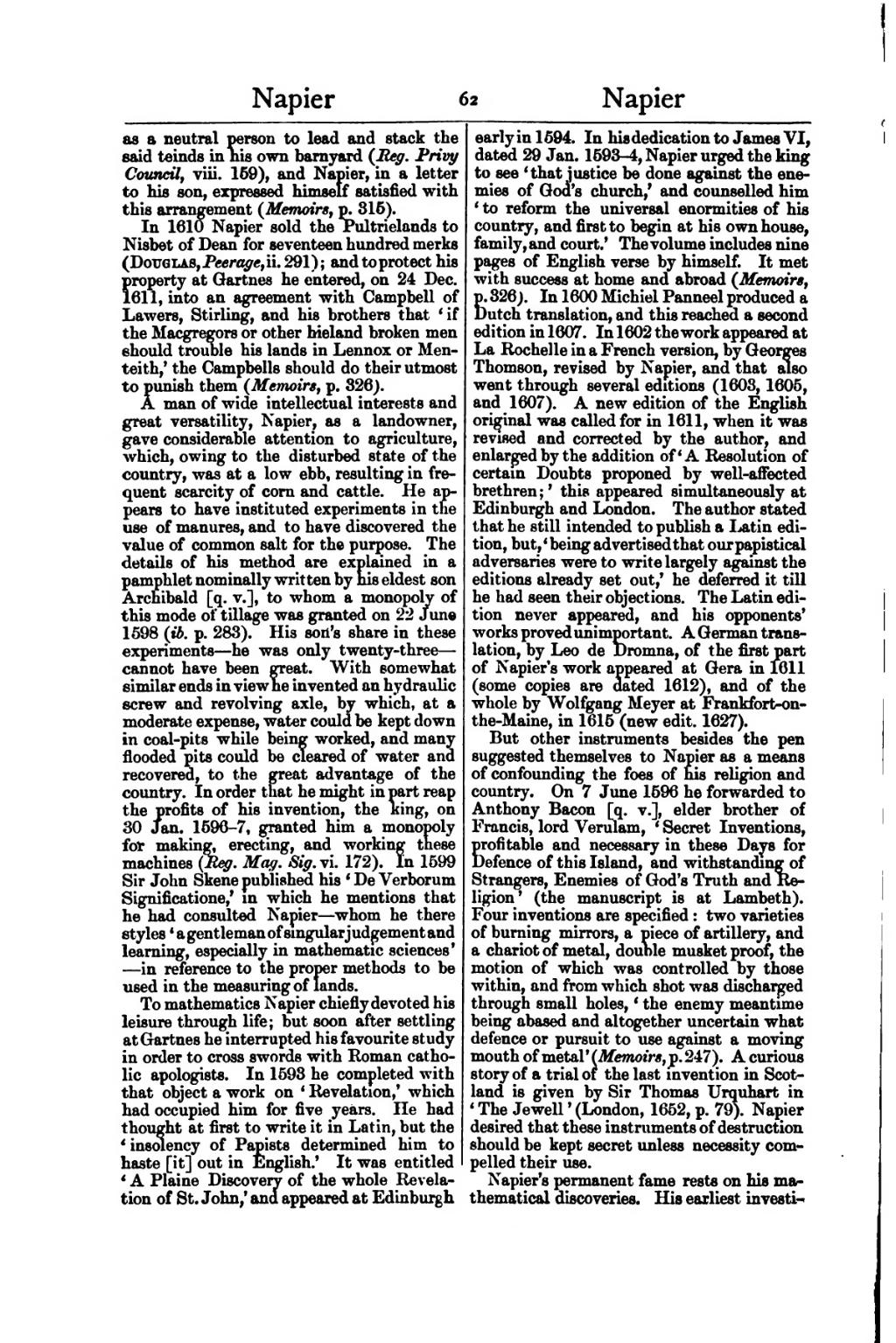as a neutral person to lead said teinds in his own barnyard (Reg. Privy Council, viii. 159), and Napier, in a letter to his son, expressed himself satisfied with this arrangement (Memoirs, p. 315).
In 1610 Napier sold the Pultrielands to Nisbet of Dean for seventeen hundred merks (Douglas, Peerage ii. 291); and to protect his property at Gartnes he entered, on 24 Dec. 1611 into an agreement with Campbell of Lawers, Stirling, and his brothers that 'if the Macgregors or other hieland broken men should trouble his lands in Lennox or Menteith,' the Campbells should do their utmost to punish them (Memoirs, p. 326).
A man of wide intellectual interests and great versatility, Napier, as a landowner, gave considerable attention to agriculture, which, owing to the disturbed state of the country, was at a low ebb, resulting in frequent scarcity of corn and cattle. He appears to have instituted experiments in the use of manures, and to have discovered the value of common salt for the purpose. The details of his method are explained in a pamphlet nominally written by his eldest son Archibald [q. v.], to whom a monopoly of this mode of tillage was granted on 22 June 1598 (ib. p. 283). His son's share in these experiments— he was only twenty-three— cannot have been great. With somewhat similar ends in view he invented an hydraulic screw and revolving axle, by which, at a moderate expense, water could be kept down in coal-pits while being worked, and many flooded pits could be cleared of water and recovered, to the great advantage of the country. In order that he might in part reap the profits of his invention, the king, on 30 Jan. 1596-7, granted him a monopoly for making, erecting, and working these machines (Reg. Mag. Sig. vi. 172). In 1599 Sir John Skene published his 'De Verborum Significatione,' in which he mentions that he had consulted Napier whom he there styles 'a gentleman of singular judgement and learning, especially in mathematic sciences' in reference to the proper methods to be used in the measuring of lands. To mathematics Napier chiefly devoted his leisure through life; but soon after settling at Gartnes he interrupted his favourite study in order to cross swords with Roman catholic apologists. In 1593 he completed with that object a work on ' Revelation,' which had occupied him for five years. He had thought at first to write it in Latin, but the 'insolency of Papists determined him to haste [it] out in English.' It was entitled 'A Plaine Discovery of the whole Revelation of St. John,' and appeared at Edinburgh early in 1594. In his dedication to James VI, dated 29 Jan. 1593-4, Napier urged the king to see 'that justice be done against the enemies of God's church,' and counselled him 'to reform the universal enormities of his country, and first to begin at his own house, family, and court.' The volume includes nine pages of English verse by himself. It met with success at home and abroad (Memoirs, p. 326). In 1600 Michiel Panneel produced a Dutch translation, and this reached a second edition in 1607. In 1602 the work appeared at La Rochelle in a French version, by Georges Thomson, revised by Napier, and that also went through several editions (1603, 1605, and 1607). A new edition of the English original was called for in 1611, when it was revised and corrected by the author, and enlarged by the addition of 'A Resolution of certain Doubts proponed by well-affected brethren;' this appeared simultaneously at Edinburgh and London. The author stated that he still intended to publish a Latin edition, but, 'being advertised that our papistical adversaries were to write largely against the editions already set out,' he deferred it till he had seen their objections. The Latin edition never appeared, and his opponents' works proved unimportant. A German translation, by Leo de Dromna, of the first part of Napier's work appeared at Gera in 1611 (some copies are dated 1612), and of the whole by Wolfgang Meyer at Frankfort-on- the-Maine, in 1615 (new edit, 1627).
But other instruments besides the pen suggested themselves to Napier as a means of confounding the foes of his religion and country. On 7 June 1596 he forwarded to Anthony Bacon [q. v.], elder brother of Francis, lord Verulam, 'Secret Inventions, profitable and necessary in these Days for Defence of this Island, and withstanding of Strangers, Enemies of God's Truth and Religion' (the manuscript is at Lambeth). Four inventions are specified : two varieties of burning mirrors, a piece of artillery, and a chariot of metal, double musket proof, the motion of which was controlled by those within, and from which shot was discharged through small holes,' the enemy meantime being abased and altogether uncertain what defence or pursuit to use against a moving mouth of metal' (Memoirs, p. 247). A curious story of a trial of the last invention in Scot- land is given by Sir Thomas Urquhart in 'The Jewell ' (London, 1652, p. 79). Napier desired that these instruments of destruction should be kept secret unless necessity compelled their use.
Napier's permanent fame rests on his mathematical discoveries. His earliest investi-
